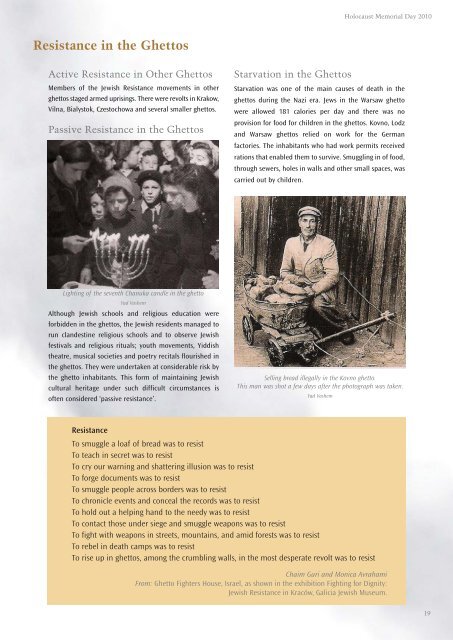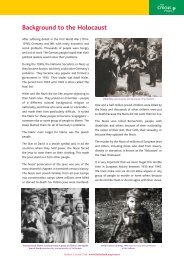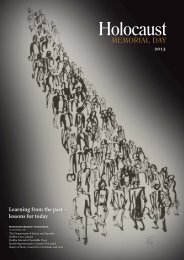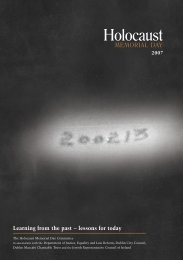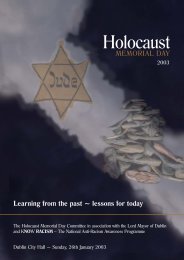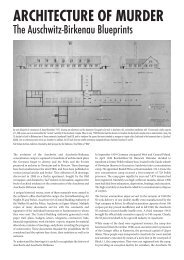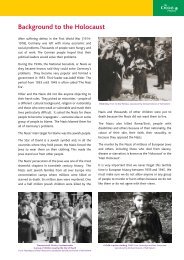Learning from the past ~ lessons for today - Holocaust Education ...
Learning from the past ~ lessons for today - Holocaust Education ...
Learning from the past ~ lessons for today - Holocaust Education ...
Create successful ePaper yourself
Turn your PDF publications into a flip-book with our unique Google optimized e-Paper software.
<strong>Holocaust</strong> Memorial Day 2010<br />
Resistance in <strong>the</strong> Ghettos<br />
Active Resistance in O<strong>the</strong>r Ghettos<br />
Members of <strong>the</strong> Jewish Resistance movements in o<strong>the</strong>r<br />
ghettos staged armed uprisings. There were revolts in Krakow,<br />
Vilna, Bialystok, Czestochowa and several smaller ghettos.<br />
Passive Resistance in <strong>the</strong> Ghettos<br />
Starvation in <strong>the</strong> Ghettos<br />
Starvation was one of <strong>the</strong> main causes of death in <strong>the</strong><br />
ghettos during <strong>the</strong> Nazi era. Jews in <strong>the</strong> Warsaw ghetto<br />
were allowed 181 calories per day and <strong>the</strong>re was no<br />
provision <strong>for</strong> food <strong>for</strong> children in <strong>the</strong> ghettos. Kovno, Lodz<br />
and Warsaw ghettos relied on work <strong>for</strong> <strong>the</strong> German<br />
factories. The inhabitants who had work permits received<br />
rations that enabled <strong>the</strong>m to survive. Smuggling in of food,<br />
through sewers, holes in walls and o<strong>the</strong>r small spaces, was<br />
carried out by children.<br />
Lighting of <strong>the</strong> seventh Chanuka candle in <strong>the</strong> ghetto<br />
Yad Vashem<br />
Although Jewish schools and religious education were<br />
<strong>for</strong>bidden in <strong>the</strong> ghettos, <strong>the</strong> Jewish residents managed to<br />
run clandestine religious schools and to observe Jewish<br />
festivals and religious rituals; youth movements, Yiddish<br />
<strong>the</strong>atre, musical societies and poetry recitals flourished in<br />
<strong>the</strong> ghettos. They were undertaken at considerable risk by<br />
<strong>the</strong> ghetto inhabitants. This <strong>for</strong>m of maintaining Jewish<br />
cultural heritage under such difficult circumstances is<br />
often considered ‘passive resistance’.<br />
Selling bread illegally in <strong>the</strong> Kovno ghetto.<br />
This man was shot a few days after <strong>the</strong> photograph was taken.<br />
Yad Vashem<br />
Resistance<br />
To smuggle a loaf of bread was to resist<br />
To teach in secret was to resist<br />
To cry our warning and shattering illusion was to resist<br />
To <strong>for</strong>ge documents was to resist<br />
To smuggle people across borders was to resist<br />
To chronicle events and conceal <strong>the</strong> records was to resist<br />
To hold out a helping hand to <strong>the</strong> needy was to resist<br />
To contact those under siege and smuggle weapons was to resist<br />
To fight with weapons in streets, mountains, and amid <strong>for</strong>ests was to resist<br />
To rebel in death camps was to resist<br />
To rise up in ghettos, among <strong>the</strong> crumbling walls, in <strong>the</strong> most desperate revolt was to resist<br />
Chaim Guri and Monica Avrahami<br />
From: Ghetto Fighters House, Israel, as shown in <strong>the</strong> exhibition Fighting <strong>for</strong> Dignity:<br />
Jewish Resistance in Kraców, Galicia Jewish Museum.<br />
19


